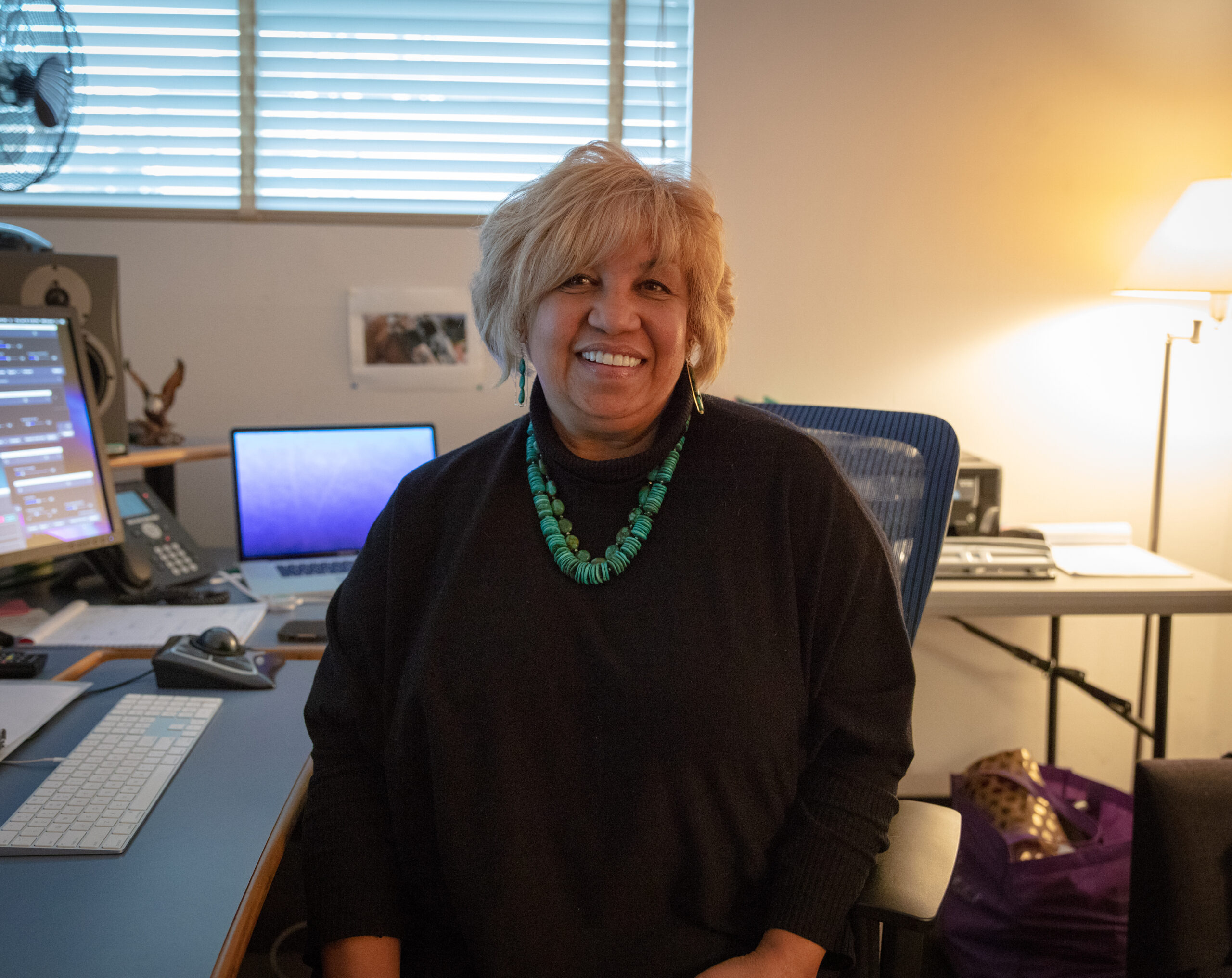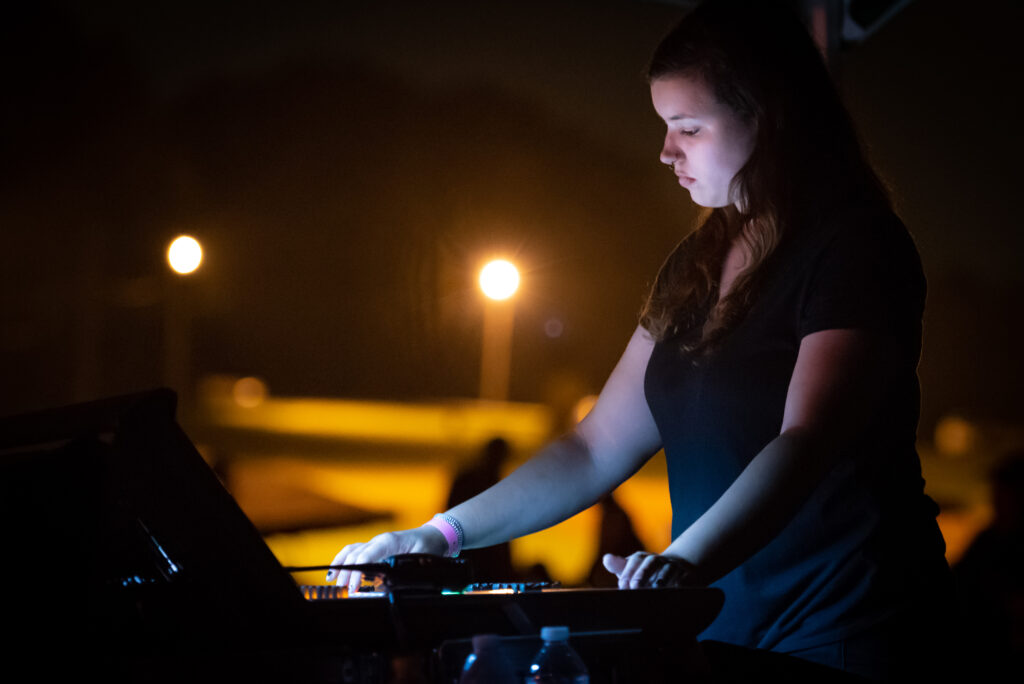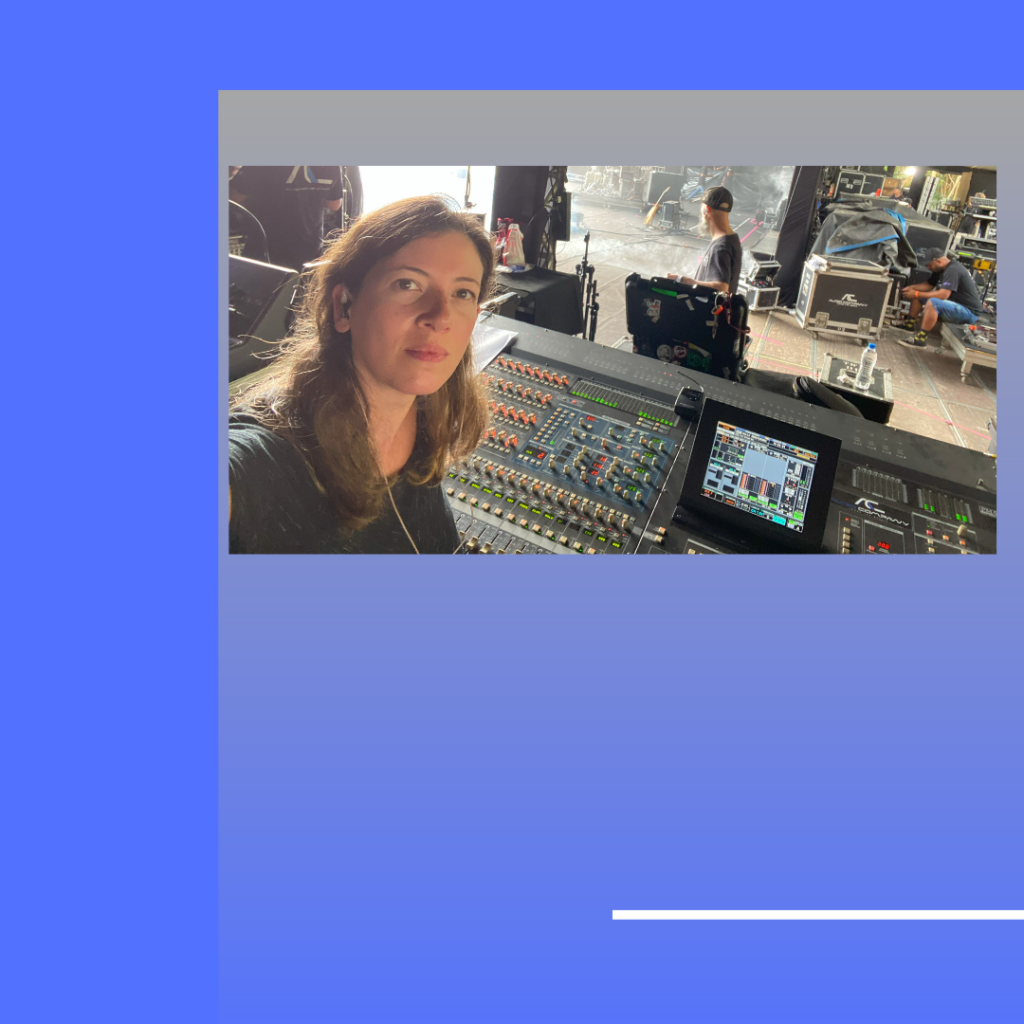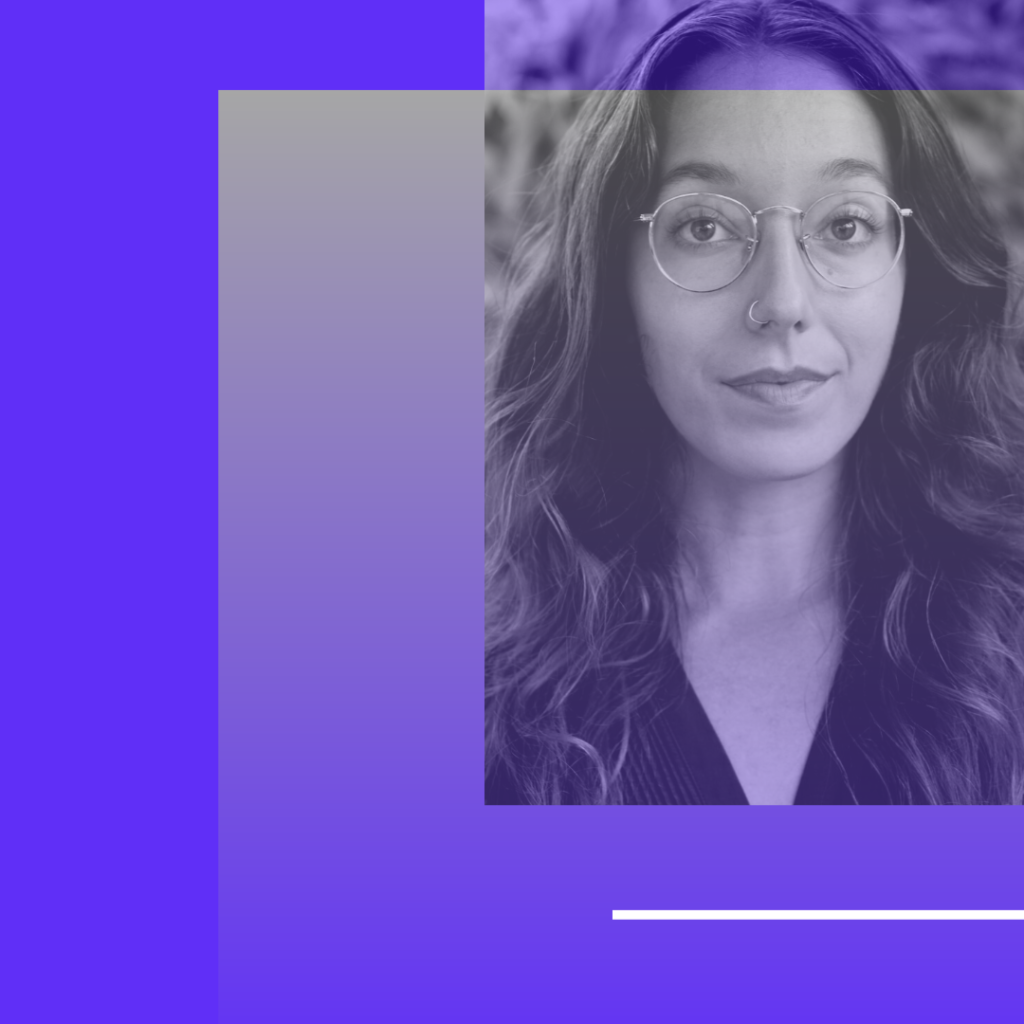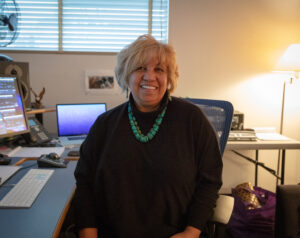 Bobbi Banks is a Supervising Sound, Dialog, and ADR Editor. Bobbi has been in the industry over 20 years with over 120 films to her credit list (including Men In Black International, Fate of the Furious, Selma, Straight Outta Compton, The Call, The Incredible Hulk, Poetic Justice, Best Man, Holiday, Pawn Sacrifice, August Osage County and Ghost Rider).
Bobbi Banks is a Supervising Sound, Dialog, and ADR Editor. Bobbi has been in the industry over 20 years with over 120 films to her credit list (including Men In Black International, Fate of the Furious, Selma, Straight Outta Compton, The Call, The Incredible Hulk, Poetic Justice, Best Man, Holiday, Pawn Sacrifice, August Osage County and Ghost Rider).
Bobbi is the past president of Motion Picture Sound Editors (MPSE), and received her first Emmy nomination in 2019 for “When They See Us,” and has won two MPSE Golden Reel Awards. She also appears in the 2019 “Making Waves: The Art of Cinematic Sound,” a documentary on the craft of sound. Bobbi was interviewed as part of the SoundGirls Living History Project.
What is ADR, and what is your today day working in ADR?
ADR is automatic dialogue replacement, where the actors have to do their lines over again because there’s noise in the background, or the director wants to add lines for the scene to tell the story, comedy lines, that kind of thing.
For ADR, we sit with the director and the film editor and we go through the entire film. We talk about areas that we might have to do over again. It could be because the scene has a lot of noise in the background, or wind machines, or ocean, or something that we can’t get out technically.
After that, then I go to the cutting room. I go through the whole film again, I write down cue sheets, like the beginning and the ending of the words [to be recorded]. After that, someone has already put the stage on hold, got the actors, let the actors know how much time we’re going to need them for. Then, the actor comes to the stage. A lot of times the directors there. Sometimes they’re not just because of business reasons. They might have other meetings and things like that depending on where they are in the project. So, I’m there, and we have to direct the actors to do the lines the same way that they recorded them in production.
Sometimes the challenge is that when they come into do the ADR, it could be like eight months to a year after they’ve actually recorded the original production. So, they’re already in a different headspace because they can be on another project, and they’ve got to switch and get back into character for that. It’s not easy. The directors don’t like it, the actors don’t like it. You have to perform all of a sudden – beep, beep, beep – and on the fourth beat, you’ve got to say the line and try to get it right the first time because then you try to do it over and over again.
The thing is, with the actors, or even the directors, you just have to figure out what kind of day they’re having quickly, and really try to get trust with them because you really want to have the best performance for them. It’s not just, ‘I need to do this line over again.’ You really want to get a good performance. So that trust is really, really important. Then after we record it, then I have to cut it, or we have other editors that may have to cut it to the picture so it looks in sync. Then we mix all the elements together at the end.
Why did you gravitate towards ADR long-term instead of something else like Foley or music?
When I was in New York, I really enjoyed cutting Foley, but I was an assistant to some ADR supervisors (Jane McCulley was one in New York, and Beth Bergeron when I moved to LA). I was able to go to the ADR stage with them and just watch how they dealt with the actors and seeing the outcome of it.
I’m an artsy kind of person and really creative, so I really liked how the whole process of it worked. When you have group actors and you have to recreate a whole scene, like, say, at a club, or stadium or a concert, and they have to pretend that they’re in the concert. The creative way of all of it is to keep recording and adding layers and layers and then cut it. Then when they get to the final mix and mix it with all the music, and then the people see it, you feel like you’re there. I want the audience to feel like they’re in that space.
So it’s creative, and I like people. I like to deal with people and challenges.
Who usually calls you first for a job?
It’s mostly the director that requests us, and it can be the post-production supervisor. If we’ve worked with the director or the film editor before, they can request us.
How did you get hired for your first few jobs? What was your very first movie or TV show that was your big break?
I worked at Sound One in New York, and I actually was an assistant to the executive assistant to the owners. Then I was an assistant bookkeeper. So, I had nothing to do with technically anything. I would travel to different departments to see what they did. I decided maybe I can clean up the sound effects library. I did stuff on my lunch hour and decided that’s really what I wanted to do. They said, ‘we really need you back here in administration,’ and I said, ‘ I really want to try this.’ They actually cut my salary. I was a single mom then, but I really wanted the challenge, so I did that for a while. Then after that, I chose sound effects for clients. After that, they really wanted me to come back to administration so I did that for a while.
Then, they had a challenge for me. They knew that I really wanted to be more technical, so they asked me to run the machine room for mix. That means all the patch bays, getting everything that the re-recording mixer needs. Back then, we had dubbers and you had to thread stuff up. I had six weeks to learn – and learn the projector. I knew nothing because I didn’t go to school for anything. I was just green. So I had my little notebook, and I’d do pictures. I had a really good teacher, Peter Riley. Six weeks later, I had my first mix.
I did that for a year. When I said I wanted to mix, they said it would be like five to seven years. When you’re young, five to seven years is a really long time. It felt like I didn’t have time for this. So I decided to quit and I started handing out my resume. I got hired by Maurice Schell on Desperately Seeking Susan as an apprentice on Madonna’s film. We worked like 100 hours a week for six weeks. That was my introduction to film. it was great, and I had great teachers. It was a lot of fun.
What prompted you to relocate from NY to LA? Now in 2020, especially with COVID, do you feel like one market has become better than the other? And do you feel like other cities are becoming good markets for people to work in now?
I moved, basically, because at the time there was more work here. At the time, it was either LA or New York. I had a small child so I said, well, let me just try. When I got here, I got a job within five days. I got a job on Texas Chainsaw Massacre 2. At the time, there was a waiting list of five years to get into the union. I got into the union within a year that I was here. It just turned out to be the right place at the right time.
I think currently you’ve got New York, LA. Atlanta now has post-production. I think another one that’s going to be rising up soon is New Mexico because Netflix (from what I hear) is going to be doing post-production there because they do a lot of production. There’s a lot of shooting that goes on in New Mexico. I think that that’s going to be another place to go.
Even with COVID, a lot of people now work from home. I was going to say the challenge is during the mix, however, we just finished working on Coming to America 2 where I wound up having to be part of the time doing the mix at home. I was able to listen to the mix and hear them in case they needed something right away, and then I have to send it through Aspera. So there is a way to be at home and be at the mix at the same time.
We’re people that are used to being with people. We missed that interaction. The personal part of it is kind of lacking a little.
Are you mostly freelance now? Do you tend to work for the same studios over and over?
I’ve actually been freelancing since 1985. I’ve never been under contract. I may work at a particular company for quite a while, but it’s not to say I can’t work at another studio because I freelance. Greg Hedgepath (who’s a supervisor as well) – we’ve worked together on like, 40 films and a few TV shows together. I’ve worked with different supervisors, too, but mostly Greg and I have worked together.
After you first got started and did your first few projects, what was the first film or TV show that made you feel like, ‘I finally made it, I know exactly what I’m doing, and I feel like I’m a professional?
I don’t ever feel that I’ve made it because each project is different, and I just care about everything I do, and we’re always learning stuff.
John Singleton hired me on Poetic Justice. It was my first supervising ADR job. Towards the end of the film, there’s a scene with Janet Jackson and Tupac where they’re sitting on the side and they’re at the beach. We had to do that whole scene over in ADR. This was my first supervising ADR job. If you look at it in the sense that was all re-recorded, they did a great job. You can’t tell that it’s not production. So I think on that day, it just made me feel so good. John and Bruce Cannon, who’s the editor at that time, really trusted me enough to do this project. So I have a really great affinity for that project because of that. If you asked me about my first project that would be it.
There’s another project I did called Higher Learning. There’s a scene where [actor] Michael Rapaport is in his dorm room, and he wants to take his life. It’s really intense with breathing, shaking of a gun, and the music. That’s such an intense scene because all the angst that’s going on and it’s just him breathing. It also tells you that not only can you create tension with people talking, but you can do it with just somebody breathing. We had to do all that breathing.
You have to find the right breath at the right moment. Those are the creative things, and that is really cool to do.
You mentioned you didn’t go to school for sound. Do you feel like now it has become really important for people to go to school to get into film and TV, post-production sound?
I believe that you can still get into it without going to school. If someone does go to school, I think that’s a huge plus because then they can learn all different aspects of things. So I wouldn’t say don’t go to school, or that your time is wasted at all because it’s not. I think that once somebody graduates, they have to be open enough to really listen and learn and take what they learned in school, plus what is going on in the active role that they’re doing.
What happens with most careers that you may have gone to school for is when you are there on the job, things are different. Some of the people that I talked to from school have a whole different way than they think things should be. So, it’s almost having to unlearn some of the things that they’ve learned in order to really flow in what they need to do and to be open to learning from other people. Because sometimes they just think that they know it all and they can’t really hear.
How has workflow and technology changed from when you first started all the way into now?
It was from film to now computer. I can’t do everything I can do now with technology, but I still like film. I like the feel of film. I like the fact that you’re always moving. At that time, you get a razor blade, and you feather off the sand, feather off of the oxidation off of the soundtrack. It’s creative, so I miss that.
But certainly, with like Izotope and different plugins that we have now, we can actually do a lot more work and more creativity with it. A lot of people, unfortunately, weren’t able to make that transition. If you’re not technically inclined, it can be a little difficult to try to get a handle on it and make it a smooth transition.
Why do you think there still aren’t a lot of black people and even women in sound? Is it mainly because people just don’t know that post-production sound is a thing or do you feel it’s more of a gatekeeping thing, that it’s hard for certain people to get into?
I would say it would be all of that. Certainly, a lot of people don’t know what we do. At the moment, I serve on several committees and in different companies and so everybody’s trying to help with that part. Doing career panels, doing workshops, things like that to get into the community so that they can see. There’s so much talent there, and because we’re behind the scenes, people just don’t know what we do. There’s a lot of people that are trying to change that.
It has been sort of a gateway. It’s very hard to get in. When I started as an apprentice, I got a lot of work. As an assistant, I got a lot of work. As I started to edit, it became a little less work. As I supervised, there was even less.
I think that as people of color, we deal with so much every day of our lives anyway. Then to go into a field where people are not appreciating who you are, or see past the exterior to see the gifts that are inside of you, is something that people just don’t want to deal with. They deal with enough every day. So, I think it’s up to us that have been in the industry for a while to mentor people and help them get around the industry.
I really believe that things are changing. I used to work with the inner-city filmmakers here. I haven’t worked yet with Ghetto Film School, but they have these summer programs for like six to eight weeks. We help them with their project and giving advice and stuff like that. Afterward, we try to get them work as interns or apprentices in different companies. There just needs to be a few more programs like that so that we can change things.
I think people really don’t realize how they might perceive another person. I think that’s part of the challenge. A lot of places are now doing unconscious bias training and it’s good for everybody – black and white. It’s good for everybody because we all have something that we didn’t realize was really there on the inside. So, I really believe that things are changing a bit.
It’s hard. It’s not been easy. There’s a few of us were on a panel the other day, and we were just talking about things that have been said to us through our career, and people just don’t think. These are things I think that it would be good to share with younger people coming up. You’ve just got to let stuff roll off and realize that most of the time people just don’t understand what they’ve just said to you.
Like, I had this orange and white running suit – It was my favorite. I wore to work. I went over to the coffee station and somebody was there and I was like, ‘Hi, how are you?’ And the person said to me, ‘I see you were working on the side of the road this morning before you get to work.’ In your brain, you’re just shocked that’s something that just happened. But, you have to understand that this person just really doesn’t get what they just said was wrong. Maybe in their mind, they thought something else, but coming to the person, that’s not how you pick it. Unfortunately, I never wore that jogging suit again.
I think even talking to people coming up to say, ‘Hey if anything happens, something weird is being said, text me.’ They can say, ‘Hey, what do I do about this?’ That’s important when you have somebody that you can talk to. I think it helps a lot.
You were nominated for an Emmy for the Netflix show When They See Us. How did that accomplishment feel? And what about the sound editorial process made that show special for you?
It meant a lot to me. Because we, people of color, don’t get to work on projects necessary that we would really love to work on. Greg and I worked on all of John Singleton’s films except for the very first one, and all of his projects are great. I just love the fact that I was able to participate on that show.
I worked in dialogue and didn’t work on ADR that one. Episode four where he’s in jail, and that breathing and all that stuff – that’s another one of those creative things where you had to make that breathing work, and it’s all that intensity of it.
Of all of the films, you worked on, which one is your favorite and why?
I don’t have a favorite because they’re all different. Working with directors are different.
Like, A League of Their Own – I was an ADR editor on that. One of my reels had that line ‘no crying in baseball,’ where Tom Hanks is yelling at the girl and she’s crying. That was special to me because I got to cut the crying. I cut the whole scene, and that whole area with him yelling at her. The thing is with crying, you’ve got to look at the throat, look at her eyes just listening for the sounds, and just picking out the right elements.
Straight out of Compton: You’ve got the concert scene going into the riot scene. We recreated the crowds along with the effects crowds. And then when you went outside, the riots, all the people, we had to re-record all those people screaming. All the cops, that whole, that whole scene was all group people. And the actors, the guys, are re-recorded as well because there was so much noise and so much over top of each other, you couldn’t understand what people were saying. So, we recreated that whole thing. So you can sit there and just feel like you’re at the concert, and you feel the intensity of the riot scene. It’s powerful. Every one has something different.
I was able to work on “Self Made: Inspired by the Life of Madam C. J. Walker,” and that was awesome because of its history. It’s our history. It’s so important that we can tell our story. Give me a chance to tell her story. It’s so impactful. I just hope more of it happens.
In the next 10 or 20 years on your career path, what are certain types of projects or genres of projects that you would like to start working on more?
We put 150% into everything we do, so every project is just as important as the other one.
I think one thing is a lot more historical pieces, maybe. I just think it’s really important to do.
What are your self-care routines and your hobbies, especially this year?
I like to drive a lot. That’s my kind of getaway thing. But during COVID and being home, I have those DIY projects. I have a patio and so I started gardening. I had strawberries, little cherry tomatoes, poblano peppers. So every morning I go and I talk to them. So now I have a new DIY project that I’m going to do which is cement cinder blocks. So I’m going to make a succulent garden with those.
Find More Profiles on The Five Percent
Profiles of Women in Audio
Original interview by Twi McCallum for the SoundGirls Living History Project
Profile edited by April Tucker
